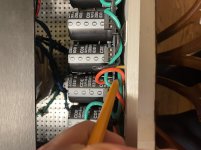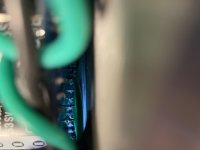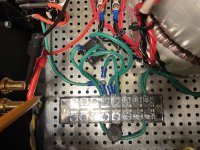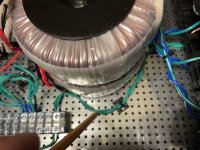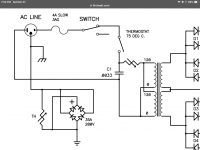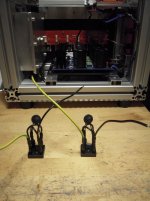Nice one Audiosan.
Do ensure that the two PSUs gnds only see each other through 10R. That would mean one Cl60 between gnd and chassis per PSU. I can only see one CL60 in you gnd connection block. That right? If so, there’s another possible loop area for you.
Such fun, humchasing. Should be a profession. Probably is...
What my previous posts did not take into account, is that in two identical halves of the amp, you have a problem in only one. I’d look for possible differences between the two.
Also, I did not take into sufficient account that it can be good to have the chassis gnd wire closer to the 0v connections (gnd links between boards) than the gnd’s to amp boards. I actually have them on different sides of the PSU, as there is not enough connection points to have them all on one side. All I can say is that trying different ways of connecting gnd wires at the PSU, can make a difference. Especially with high bias on a class A amp.
Too many tips, and words, for one night. And back and forth, i am sorry... Best of luck, stayer of the year Luvrockin!
Do ensure that the two PSUs gnds only see each other through 10R. That would mean one Cl60 between gnd and chassis per PSU. I can only see one CL60 in you gnd connection block. That right? If so, there’s another possible loop area for you.
Such fun, humchasing. Should be a profession. Probably is...
What my previous posts did not take into account, is that in two identical halves of the amp, you have a problem in only one. I’d look for possible differences between the two.
Also, I did not take into sufficient account that it can be good to have the chassis gnd wire closer to the 0v connections (gnd links between boards) than the gnd’s to amp boards. I actually have them on different sides of the PSU, as there is not enough connection points to have them all on one side. All I can say is that trying different ways of connecting gnd wires at the PSU, can make a difference. Especially with high bias on a class A amp.
Too many tips, and words, for one night. And back and forth, i am sorry... Best of luck, stayer of the year Luvrockin!
Last edited:
Tried to get some pics of the grounds. They turned out kinda bad
Attachments
the GND from PSU to amp comes from one "side" of the PSU. The one next to it goes to chassis earthand same for the other ch

I agree, that might not be a problem at all. But to rule it out, it is more flexible to be able to try different connections to see what makes the quietest one, and then solder when happy. At least if all else fails.
Last edited:
Tried to get some pics of the grounds. They turned out kinda bad
I see it. As suspected. the GND's are tied together before the grondbreaker. Also, i see both a CL-60(?) and a brigde rectifier as grondloop breaker. It should be one or the other. But you need 2 of the the version you choose. GNDgroundloop breaker-chassisearth. And the same for the other ch
Got it, thank you! I’ll jump on it in the AM. I basically I can just remove the (2) ground wires coming back to the block from the psi boards and isolate them then take each to ground with the thermistor until I get the wire Monday, correct?
The CL-60 goes across the bridge, it is not cal-60 «or» bridge. Using a bridge rectifier as loop breaker, the CL-60 is a part of the loop breaker. The schematic is correct.
So, use either CL-60, or CL-60+bridge. Times two.
Same goes for fuses. There should be two separate fuse holders. If using the stores PSU inlet for dual mono, you are in effect using two times the fuse size that will actually break if you have a fault in the circuit.
Andy
So much for a «quick» look at the pics. You do have separate fuses! I think the amp looks like a good job done, Luvrockin. And you’ll nail this hum issue, a likely problem has been identified, and if that doesn’t do the trick (loop breakers/CL-60, there are still some PSU improvements that might possibly do the last trick. So maybe you’ll soon be able to put the amp in your main system and enjoy beautiful music. Pass designs are their own breed =)
I must again give it to you: stayer of the year!
I must again give it to you: stayer of the year!
to luvrockin #990
Hello luvrockin,
if you have reached 51°C at your heatsinks (with a room temp of around 23-24°C) , then I think there is not much or close to no headroom for biasing higher.
You also have to imagine, that in summertime room temperature will be higher and your amp will run hotter.
Danger of thermal runaway, if it gets too hot. No
 please....
please....
Greets
Dirk
Hello luvrockin,
if you have reached 51°C at your heatsinks (with a room temp of around 23-24°C) , then I think there is not much or close to no headroom for biasing higher.
You also have to imagine, that in summertime room temperature will be higher and your amp will run hotter.

Danger of thermal runaway, if it gets too hot. No

 please....
please....Greets
Dirk
Hello luvrockin,
if you have reached 51°C at your heatsinks (with a room temp of around 23-24°C) , then I think there is not much or close to no headroom for biasing higher.
You also have to imagine, that in summertime room temperature will be higher and your amp will run hotter.
Danger of thermal runaway, if it gets too hot. Noplease....
Greets
Dirk
51c is not hot at all. There is no problem running the sinks at even 60c. Thermal runnaway is not an issue now that the diodes are gone.
Just make sure that the thermistors have good contact with the output fets plasticbody.
Unfortunately that's not true at all, AudioSan.
The MOSFETs have to be kept Tj<100C at all times. With a 30W heat input and excellent thermal contact to 0.25C/W, that's a Tc of 68 for a sink temperature of 60 degrees. The Tj-c of IRFP MOSFETs is almost 0.8C/W, which yields 92 degrees, and that is not much headroom at all.
The 55C indicated in the article is quite the upper limit. I do know you can run MOSFETs hotter, but the output stage transfer function changes quite a lot at higher temperatures, which you can deduce from the Vgs-Id curves at different temperatures. This is also part of the reason that MOSFETs are not recommended by manufacturers for linear applications any more (that's not to say we shouldn't find fun ways to use them anyway). In pulsed applications it is possible, sometimes desirable, to have a hot die. Requires less Vgs for same Id at higher temperatures.
IRL in amplifiers, the cooler the MOSFET, the better. A fan is a much better solution if one is okay with the thrum at low output levels.
The MOSFETs have to be kept Tj<100C at all times. With a 30W heat input and excellent thermal contact to 0.25C/W, that's a Tc of 68 for a sink temperature of 60 degrees. The Tj-c of IRFP MOSFETs is almost 0.8C/W, which yields 92 degrees, and that is not much headroom at all.
The 55C indicated in the article is quite the upper limit. I do know you can run MOSFETs hotter, but the output stage transfer function changes quite a lot at higher temperatures, which you can deduce from the Vgs-Id curves at different temperatures. This is also part of the reason that MOSFETs are not recommended by manufacturers for linear applications any more (that's not to say we shouldn't find fun ways to use them anyway). In pulsed applications it is possible, sometimes desirable, to have a hot die. Requires less Vgs for same Id at higher temperatures.
IRL in amplifiers, the cooler the MOSFET, the better. A fan is a much better solution if one is okay with the thrum at low output levels.
Papa-quote:
«Personally, I try to not run heat sinks greater than about
50 deg C, and cases above 25 watts, which gives me about 90,
maybe 100 deg C for chip temperature.
Most Pass Labs products run semis in the 10-15 watt range»
Papa-quote 2:
« Blimey hot is 10 seconds hands on = 45 deg C.
Crikey hot is 5 seconds = 50 deg C.
Bloody hot is 2 seconds = 55 deg C.
X*?@! is 60 deg C.
All of these are within an acceptable range, although
X*?@! is resrved for the more mature constructor»
55 degrees is normally measured 30 degrees above ambient. With ambient of 22,5 degrees. One should therefore target approx 52 degrees to stay out of the «more mature constructor» range. Iow just what Dirk and Sangram said.
Regards,
Andy
«Personally, I try to not run heat sinks greater than about
50 deg C, and cases above 25 watts, which gives me about 90,
maybe 100 deg C for chip temperature.
Most Pass Labs products run semis in the 10-15 watt range»
Papa-quote 2:
« Blimey hot is 10 seconds hands on = 45 deg C.
Crikey hot is 5 seconds = 50 deg C.
Bloody hot is 2 seconds = 55 deg C.
X*?@! is 60 deg C.
All of these are within an acceptable range, although
X*?@! is resrved for the more mature constructor»
55 degrees is normally measured 30 degrees above ambient. With ambient of 22,5 degrees. One should therefore target approx 52 degrees to stay out of the «more mature constructor» range. Iow just what Dirk and Sangram said.
Regards,
Andy
Last edited:
- Home
- Amplifiers
- Pass Labs
- F5Turbo Illustrated Build Guide
